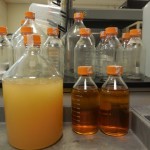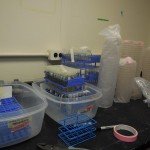Jul
16
Bacteria, Broth, and More
Hey Hawkeyes,
My last post was about my class and my trip to Chicago, but you may be wondering what do I do in my free time? Well, to answer that I am proud and excited to say that I am working in a lab on campus. I’m so excited to be involved in research and I am learning so much! During the chemical engineering seminar (the one we made ice cream in), different professors came to talk about their research projects. After a few weeks of having no interest in the projects being presented, a project sounded immensely interesting. After class I approached the professor about a research position over the summer. He said he would have to check the budget, but that his grad students were getting tired of making the media for the experiments. He asked me to email him so we could set up a meeting. During the meeting he showed me the labs and talked about what I would be doing. I would mainly be washing glassware and making media, but if one of the grad students was gone, I would fill in. When he asked if I would like to work in his lab, I was definitely ready with a YES!
Basically the project I’m helping with is half of a larger project. The lab I’m helping with is working with bacteria. I make the broth to feed the bacteria and wash dishes (broth bottles and test
tubes) along with making sure everything is clean. So basically my day goes like this: Get to the lab and begin making broth. Each broth takes 10 minutes in the microwave, so while it’s cooking I wash empty bottles and let them dry. When the broth is done, I pour it into a bottle that now has to be autoclaved (high temperature and high pressure) for an hour to sterilize it. The empty bottles, once dry, must also be autoclaved for an hour. While the bottles are in the autoclave, I wash the test tubes. When test tubes come in, they have some of the bacteria in them so they must be autoclaved before being washed. After they have been washed and have dried for two days, I put the caps back on them and autoclave them again. Then some of them are filled with broth and autoclaved again. After the grad students conduct the experiment, they bring the 5 liter bottle of waste over. The waste must be autoclaved, dumped, and then the bottle must be washed and autoclaved. Unfortunately, the waste tends to smell and if we dump it during normal hours, people don’t like it. So we try to dump it at the end of the day so there aren’t very many people around. Every couple of days I have to go to a different building and get de-ionized water. I usually have to make about 10 liters of broth everyday, autoclave everything for an hour before I use it, and then again for another hour after I’ve used it. To keep things running smoothly, it takes a bit of strategy. Oh, and did I mention the agar? The agar goes on the bottom of the petri dishes that we grow the bacteria on. It has to be cooked for 15 minutes and then autoclaved for an hour.
Immediately after it comes out of the autoclave it has to be poured into the plates because it becomes solid at room temperature. Which means that all the dishes used to make the agar (which are the same ones we use to make broth) have to dry before we can clean them because it’s so sticky.
Now factor that into the time strategy. Oh, and add in the fact that the broth has to be made the day before they need it because they can’t use it when it’s hot (and after being autoclaved, it’s boiling) and if it’s made too far in advance it will go bad and have to be dumped (which means I have to make more to replace it). I love where I’m working though. I’m learning so much and it’s great experience with the lab equipment. I also really like the people I’m working with so work is usually a lot of fun.
I even took some pictures of the lab for you guys.
The empty ones in the back have been washed and autoclaved. The large yellow, cloudy one is waste that has to autoclaved and dumped. The two little ones are what the broth is supposed to look like, except there need to be 8 more in order to be ready for the next day.The tape on the lids is autoclave tape and the stripes turn from white to black after being autoclaved, but only if the autoclave reaches the correct temperature to sterilize the equipment.
I hope at least some of that made some sense to you. It’s sort of confusing when I try to explain it to people so if you have any questions, just comment! Thanks for reading!



 Subscribe to Sarah's blog via RSS
Subscribe to Sarah's blog via RSS